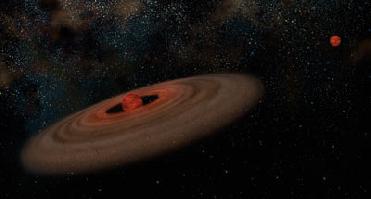
An artistic conception of the binary system showing the primary brown dwarf. A Hubble Image
WASHINGTON (BNS): In an interesting finding, astronomers have detected a planet-like object revolving around a brown dwarf in the Taurus star-forming region.
This mysterious 'companion' of the brown dwarf is estimated to be 5 to 10 times the mass of Jupiter and appears to be circling the brown dwarf from a distance of 3.6 billion kilometers.
Astronomers have traced the planet-like object with the help of Hubble Space Telescope and Gemini Observatory. The brown dwarf was spotted in a survey of 32 young brown dwarfs lying in the Taurus star-forming region.
What the astronomers find intriguing, however, is that the new-found object was formed in less than one million years -- the approximate age of a brown dwarf -- and much faster than the predicted time it takes for a planet to form.
In order to find answer to the question – whether the object should be called a planet –scientists have taken into consideration three possible scenarios of its formation: Dust in a circumstellar disk slowly agglomerates to form a rocky planet 10 times larger than Earth, which then accumulates a large gaseous envelope; a lump of gas in the disk quickly collapses to form an object the size of a gas giant planet; or, rather than forming in a disk, a companion forms directly from the collapse of the vast cloud of gas and dust in the same manner as a star or brown dwarf.
Of the three, the last scenario appears more correct, say the scientists who have published their finding in The Astrophysical Journal.
If the last scenario is correct, then this discovery demonstrates that planetary-mass bodies can be formed through the same mechanism that makes stars. This is the likely solution because the companion object is too young to have formed by the first scenario, which is very slow. The second mechanism occurs rapidly, but the disk around the central brown dwarf probably did not contain enough material to make an object with a mass of 5-10 Jupiter masses.
“The most interesting implication of this result is that it shows that the process that makes binary stars extends all the way down to planetary masses. So it appears that nature is able to make planetary-mass companions through two very different mechanisms,” said team member Kevin Luhman at the Penn State University.
If the mystery companion formed through cloud collapse and fragmentation, as stellar binary systems do, then it is not a planet by definition because planets build up inside disks.
Further supporting evidence comes from the presence of a nearby binary system that contains a small red star and a brown dwarf.
According to Luhman, all the four objects may have formed in the same cloud collapse, making this in actuality a quadruple system. “The configuration closely resembles quadruple star systems, suggesting that all of its components formed like stars,” Luhman said.
 Previous Article
Previous Article Next Article
Next Article













The Indian Air Force, in its flight trials evaluation report submitted before the Defence Ministry l..
view articleAn insight into the Medium Multi-Role Combat Aircraft competition...
view articleSky enthusiasts can now spot the International Space Station (ISS) commanded by Indian-American astr..
view article